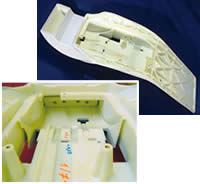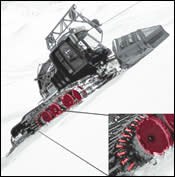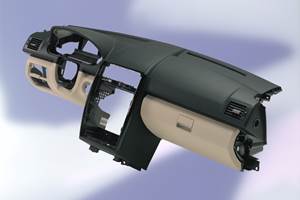Nylon RIM Expands into Niche Applications
Nylon reaction injection molding has made slow, steady progress in Europe over the past decade, and a new supplier hopes the time is right for a market push in North America.
Nylon reaction injection molding has made slow, steady progress in Europe over the past decade, and a new supplier hopes the time is right for a market push in North America. Three relatively new European applications illustrate why. One demonstrates technical progress in nylon RIM with the use of lost-core molding. And all three show off the combination of material properties, design freedom, and molding economics that could open up opportunities here.
Last September, Germany’s Brüggemann Chemical acquired the DSM RIM Nylon business (consisting of Nyrim and Star-Rim polymers) from DSM Fibre Intermediates BV in the Netherlands. Brüggemann Chemical is a supplier of plastics additives. Its U.S. office is near Philadelphia. DSM has a long-term agreement with Brüggemann to support Nyrim marketing and sales and to supply caprolactam for the Nyrim system, according to Jorn Boesten, product manager for RIM Nylon at DSM Venturing & Business Development in the Netherlands.
Nyrim is an elastomer-modified nylon 6 block copolymer whose reactive components have a water-like viscosity during processing but cure in the mold to form a high-molecular-weight nylon polymer. Elastomer content varies from 7% in the Nyrim 700 grade up to 40% in Nyrim 4000. High rubber levels allow Nyrim 3000 and 4000 to compete directly with TPEs such as DuPont’s Hytrel copolyester. Nyrim can be injected into a mold containing glass mat or it can be blended with mineral fillers such as wollastonite.
Nyrim is said to perform very well in stiffness/toughness balance, fatigue and abrasion resistance, and low-temperature toughness. Nyrim can be used at temperatures up to 284 F continuously and 356 F intermittently. Nyrim also has excellent resistance to many chemicals, except for concentrated acids. It can be pigmented or painted with standard industrial paints. Since it is a thermoplastic, scrap can be reused for injection molding like regular nylon.
Heavy-duty parts
In the early 1990s, DSM RIM Nylon targeted automotive vertical exterior panels and under-hood applications such as manifolds. However, Nyrim’s cost (higher than other RIM materials) proved to be an obstacle, and its properties exceeded the requirements. The company then changed direction, focusing on large, complex industrial parts that don’t require painting. Many of the applications are molded in black or other industrial colors.
Nyrim has been successful in replacing aluminum in large components of agricultural and other heavy-duty specialty equipment. A typical example is an agricultural crusher for making animal feed. It’s a thick part, measuring 7.8 x 2.3 in., that has to meet extreme requirements for toughness and impact resistance. It is difficult to make with other plastic materials or processes because of large and abrupt changes in thickness. It also has metal inserts molded in.
Another interesting application is a complex omega-shaped profile strip that protects the top and rear of a pickup truck bed. Three segments are each 5 to 6 ft long. When molded in other RIM materials, the parts could not be demolded without memory effects.
Other applications include enclosures for railway electronic equipment, pump housings, industrial motor housings, impellers, military mortar bases, and dowels for tunnel construction. In North America, a highly glass-reinforced Nyrim is being used by one company to produce 40-in.-diam. manhole covers and sumps for gasoline stations.
Lost-core adds potential
One of the newer and most innovative uses of Nyrim is a two-piece dentist’s chair molded by Ensinger Tecarim of Austria. Parts integration was made possible by lost-core technology, which resulted in a 24-lb seat and a 9-lb back. Wall thickness ranges from 3 in. down to 0.024 in. in one part. According to DSM’s Boesten, PUR or DCPD RIM would re quire more parts and thus more tooling and assembly cost. Moreover, Nyrim’s reactivity can be adjusted to allow injection times to as long as 45 sec. That makes it easier to fill these complex shapes with their various thick and thin sections. Part-to-part cycle time is about 8 min.
The core is made of a salt that is washed out of the molded part with hot water. The core leaves square holes for the top part of the chair to fit into the seat without requiring sliding cores in the mold.
Another recent application exploits Nyrim’s excellent impact and fatigue resistance in track pads for caterpillar treads on heavy equipment working in peat bogs, swampland, and membrane-lined landfill sites. Individual Nyrim segments measuring 4 to 5 ft wide are bolted to a metal chain. The track is much lighter than the steel pads it replaces, saving up to 9000 lb per vehicle. This allows for an increase of payload capacity without damage being done to the ground. Nyrim’s self-cleaning surface, abrasion resistance, and thick-section moldability are also key for this application. The non-corrosive track pads reportedly maintain their shape after years of use.
In a third new application, the low-temperature impact resistance and weight-saving potential of Nyrim are shown in its successful replacement of cast steel in wheels and wheel guides for snow groomers. The RIM design allows economical molding of large, thick parts—wheels weigh 35 lb and are up to 5 in. thick—and allows for molded-in metal inserts. Use of Nyrim reduced the weight of the machine by more than 500 lb, thus increasing the work interval between refueling. As snow groomers weigh about 18,000 lb and are used on steep slopes, the wheels and wheel guides need to be very tough yet must have elasticity and wear resistance at low temperatures (-40 F).
Related Content
Hybrid EPDM-TPE Adhesion Compounds for Automotive Industry
Kraiburg’s new compounds targeted to auto sealing and exterior sector applications and toolmakers.
Read MoreThermoplastic Elastomers With Recycled Content for Automotive Applications
Avient announced new grades of TPE to meet demand for recycled content.
Read MoreExpanded Line of ‘Super’ Soft TPEs for Medical Devices
Kraiburg TPE has expanded its Thermolast M series of TPE compounds by additional hardness degrees.
Read MoreTracing the History of Polymeric Materials -- Part 29: Polyurethane
This material family has unparalleled versatility, not only in terms of the forms the material can take, but in the different ways in which it can be processed.
Read MoreRead Next
Making the Circular Economy a Reality
Driven by brand owner demands and new worldwide legislation, the entire supply chain is working toward the shift to circularity, with some evidence the circular economy has already begun.
Read MoreSee Recyclers Close the Loop on Trade Show Production Scrap at NPE2024
A collaboration between show organizer PLASTICS, recycler CPR and size reduction experts WEIMA and Conair recovered and recycled all production scrap at NPE2024.
Read MorePeople 4.0 – How to Get Buy-In from Your Staff for Industry 4.0 Systems
Implementing a production monitoring system as the foundation of a ‘smart factory’ is about integrating people with new technology as much as it is about integrating machines and computers. Here are tips from a company that has gone through the process.
Read More
























